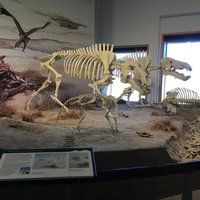On National Fossil Day, Celebrate Woolly Mammoths in South Dakota and Saber-Toothed Cats in California
As the National Park Service celebrates fossils, make plans to visit these three prehistoric tourist attractions.

Make no bones about it: fossils tell fascinating stories. The National Park Service created National Fossil Day, October 12, to remind us of how fossilized teeth, bones, plants, and other bits provide clues about the Earth’s past. Here are three sites whose interesting fossils connect you to long-ago epochs.
,
Los Angeles, CA
It’s the teeth that get your attention. The seven-inch canines of the saber-toothed cat,
Smilodon fatails,
made him a fearsome predator even at just three feet tall. When he would “bite down,” it was usually to rip the head off something. The formidable cat, California’s state fossil, roamed in the Pleistocene Era, some 40,000 to 11,000 years ago. Some 2,000 of these frightening creatures have been recovered from Rancho La Brea. At La Brea Tar Pits, watch the 3-D film “Titans of the Ice Age,” observe scientists working with fossils, and ogle recreated skeletons of
Smilodon,
the extinct California condor, coyotes, wolves and even a camel.
Agate Fossil Beds National Monument
, Harrison, NE
A chance discovery by James Cook in the 1880s on his Agate Springs Ranch led to the find of one of the world’s most significant mammal sites of the Miocene Epoch, a time period that stretched from 19 to 21 million years ago. What Cook thought was the fossilized roots of a plant turned out to be the den of an ancient beaver,
Palaeocaster,
a critter that had long, curved teeth and clawed forelimbs for digging.
Excavations of two hills in the 1900s revealed the fossils of many other interesting animals, including beardog,
Daphoenodon,
which means “blood-reeking tooth;” the rhinoceroses-like
Menoceras
, and the bison-sized
Daeodon,
an omnivore with a three-foot-long head. The Visitor Center’s diorama re-creates the skeletons of these long-ago animals.
,
Hot Springs, SD
At the Mammoth Site of Hot Springs, one of the world’s richest Ice Age, or Pleistocene era, mammoth sites, the bones of Columbian and Woolly mammoths were found
in situ,
where the animals died. Some 26,000 years ago the beasts lumbered over to a pond to drink when a giant sinkhole collapsed part of the pond’s bottom, resulting in a 60-plus foot deep death trap for the thirsty animals.
Inside the facility, a series of ramps encircle the dig. It’s easy to imagine the animals’ huge size as several of the skeletons remain mostly intact. Curved tusks lie near a giant jawbone. Long thigh and leg bones protrude from the dirt. Skeletal ribs outline the massive girth of these extinct animals. Look carefully and you also discover smaller fossils of young mammoths.